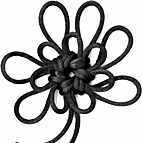Good Luck: Heptagonal
 Behold the Heptagonal good luck knot. An alternate term for a seven sided figure is septagon, but in an effort to minimize confusion, let’s stick with “heptagon”.
Behold the Heptagonal good luck knot. An alternate term for a seven sided figure is septagon, but in an effort to minimize confusion, let’s stick with “heptagon”.
I consider a polygonal knot to be a rotationally symmetric knot where the structural loops are centrally located with one ear for each structural loop. There are a number of square knots that do not have triangular or hexagonal variants (eg. the sauvastika knot). The most interesting ones, however, usually have triangular variants and can also be expanded without limit. The problem with polygonal (n-gon) knots is that as n gets large, the hole in the centre of the knot gets large, and the knot as a whole loses stability. It is hard to tension properly and the knot becomes fragile. The solution to this problem is to overlap the structural loops more which shrinks the central hole and also increases the surface area of the points of contact, which means more friction, which means a more stable knot. If you ever have the opportunity, try tying a knot with cord of the same size, one in rayon and one in nylon and see the difference the more slippery rayon makes.
The usual… formula (?) for overlaps is: one for triangular or square, two for pentagonal or hexagonal, three for heptagonal or octagonal, four or more for anything bigger (not that polygonal type knots are often constructed that are much bigger than octagonal). Of course, you can overlap more than necessary for interesting effects (maybe I should do an overlap sequence when I’m done with good luck knots and crowning?).
On a whim, I decided to tie this knot with an overlap of 2. You can see from the picture that the hole in the middle is much larger than usual. Possibly because of the doubled cords of the good luck knot, this knot has no issues with stability. To more clearly see what is going on, have a look at the {7/2} versus the {7/3} star polygons.